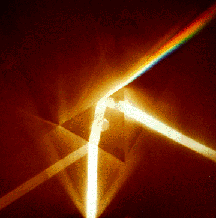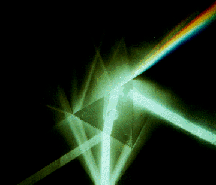Submodule 2: Lenses, Mirrors, and Prisms: Objective 1
Steve Beeson, Arizona State University

Do any of the objects in your Optics Discovery Kit make a rainbow? Try looking through some of them at a light source.
The slide-looking piece is called a diffraction grating, a piece of plastic which has many tiny grooves etched into it which separate white light into its component colors.
Are there other optical elements from your Discovery Kit that might make a spectrum of colors?
Use your flashlight with a piece of paper over the front (with a small slit cut in the paper) to make a small beam of light. Shine this beam on the prism
in your Kit and let the refracted beam fall on a piece of white paper. What do you find?Isaac Newton first saw a spectrum in this way in 1672 when a stray beam of sunlight in his darkened room happened to land on a prism.
Prisms are often the easiest way to see a spectrum, since many different objects can sometimes act like prisms. Raindrops or a glass of water, for instance, can act like a prism and disperse light into its color spectrum.
 Modules
Modules
 Light & Optics
Light & Optics
 Submodule 2
Submodule 2
 Readings
Readings
 PiN Homepage
PiN Homepage
 ACEPT
ACEPT
 Glossary
Glossary
 Help
Help

 Click here
Click here How else can we manipulate light?
How else can we manipulate light? Top of the Page
Top of the Page